
| ...from The Evansville Courier Friday, July 27, 1962 |
The death of a building can be as sad a thing as the death of a friend. In fact, some buildings are dear old friends—the home where one grew up. the church that sheltered solemn happy hours, the theater that was one's first experience with the magic world of let's pretend. |
It is a sad thing, therefore, to write the obituary for a place hundreds of us in the Tri-State have cherished with almost the warmth of feeling one usually does not hold for an inanimate object. |
The Grand Theater has not been a "thing" to many of us. It has been an escape into the world of make-believe, an adventure with the fabulous figures of the screen, a joyous session with many an inspired musician, a merry visit with rollicking clowns,tumbling acrobats, twinkling dancers. and all the glamorous show people of the last three quarters of a century. Its older friends can even recall the days when touring companies and stock companies of the first echelon played The Grand as casually and as regularly as any of the New York theaters. |
There were several theaters in the growing city of Evansville, such as the first genuine legitimate theater, the Evansville Opera House, located at the corner of First and Locust Streets (where Davidson-Amos is now), opened Sept. 9, 1868 with a local show and formally opened Sept 10, 1868 with the Mary Rickords Co. presenting a play. Remodeled in 1890 as the Peoples' Theater, it was destroyed by fire the next year, then rebuilt and dedicated as the Peoples in 1892. Other entertainments were presented at Turners Hall, a large frame building at Elm and Center (now Second and Ingle) Streets, built in 1866; at the Apollo, on the east side of Third Street between Locust and Walnut Streets, used from around 1874 until 1899, and Evans Hall, dedicated to Temperance by Mrs. Saleta Evans in 1878, which was condemned in 1931 and torn down to make way for the Central Library building. |
It was in 1889 that Evansville was to get its finest theater - one to rank with any in the country [at the time] - when a group of prominent citizens saw the need for a modern theater in keeping with the growing city. Among them were Sam Vickery, S. E. Gilbert, A. M. Weil, Ed Viele, E. S. Rogers, A. C. Rosencranz, and J. H. O'Dell. Funds were raised and the house was built on Sycamore Street, just off Second Street, adjoining the B. M. A. (now [1962] the Grein Building). The Grand Opera House . . . was a large house as theaters went in those days, with huge stage and fine arrangement of handsome upholstered seats, a balcony, foyer, lobby, rest rooms, and dressing rooms. It was said that no theater in the Middle West could equal it. The architect was named Macklefatrick. |
It’s opening was a gala event. All 1700 seats were sold in advance at an auction held in the theater on its completion when the public was invited in on an open house affair to examine the new facilities. The opening attraction October 17, 18 and 19 1889 was the Emma Abbott opera company singing Lucia, Bride of Lammermoor. |
Regular prices after opening night were .50 to $1.50 with boxes at $4.50 and $10.00. The second night the company presented Rose of Castile with a Fra Diavolo for the Saturday matinee and La Traviata that night. |
The last major opera production at the Grand was presentation of la Boheme to a partially full house on November 20, 1958 by the New York Opera Festival Group presented by the Wagner Opera Company in a tour of 40 U.S. and Canadian cities. |
The next attraction booked in for October 21 was Rice’s super $20,000.00 burlesque spectacle Corsair. |
The house enjoyed great success for, from then on, the number of touring attractions headed by the best stars of the day increased, and Evansville had its generous share. |
In 1910 the well known Orpheum vaudeville circuit, playing only the large principle cities, took over and presented shows of seven acts along with an orchestra and motion picture news reels daily, until December 31, 1911. Then came popular priced vaudeville three times daily with a bi-weekly change of bill until 1922. For several seasons stock came back. |
All over the country theater went into a slump around 1920, Courier entertainment editor emeritus Karl Kae Knecht, who had covered it all since 1906, recalls. |
The Grand was refurnished and sometimes remodeled down through the years. In 1931 Arthur Hassenall leased and remodeled it, and during the changes, the gallery was closed off. He presented stock, some road shows, and then adopted a motion picture policy. |
Since September 16, 1938 the Fine brothers – Jessie, Oscar, and Isadora -- have operated the Grand featuring first run movies and an occasional stage show. |
The Grand’s last touring road show was presented in January of 1940 when Eric Linden starred in Golden Boy. There were a few performances by local talent and several programs of individual acts between that and the last big live presentation of la Boheme in 1958. |
There'll be many a memory prodded by this painfully written story. Among them will no doubt be some happy memories of Norman and Frederick Scholz . whose father, the late Charles Scholz , took over management of The Grand in 1900 four years before his father, Frederick J. Schulz, bought Hotel Vendome. For Norman this started a lifelong romance with the theater and theater people that is evident today, with most show folks still looking on the Vendome as their Evansville headquarters. |
In the days of the early 1900's, Norman Scholz recalls the Grand was the "upper crust house" and the Peoples was open on Friday, Saturday, and Sunday only. The Grand was also used extensively then as a town hall and school commencements, political rallies, convention sessions, and home talent shows were part of the regular program. On Sept. 28, 1908 presidential candidate William Howard Taft spoke there after being introduced by local attorney Phelps Darby. On May 24, 1908, Scholz sold his theater interest to Pedley and Burch of Owensboro. Ky. |
A Look at an old Grand engagement book reads like a Who's Who in the Theater for that generation, sparkling with such legendary names as Otis Skinner, Mrs. Fiske, Anna Held, Murray and Mack, Rose Melville. Al G. Fields, Richard Mansfield, Julia Marlowe, John Griffith, and dozens more. |
Old programs also recall such special interest events at the Grand as when Miss Frances Golden, the week of Feb 5, 1911 was appearing in an act, "Yactics." A native of New Harmony, Ind, Miss Golden (our dear Aunt Fanny to all local little theater workers) was the daughter of Bella and Martin Golden, bright names of American theater history. And did you know that when Richard Gerard Sr., than a bellboy at the Vendome, joined the Premier Harmonists, it was the start of "Sweet Adeline?" Gerard joined the group, booked for four days in 1909, when the tenor became ill, and went on with them for their vaudeville bookings. Pressured to sing Harry Armstrongs' "My Old New England Home," the quartet decided it didn't care for the lyrics although the melody was ideal for harmonizing. |
One night after a show Armstrong Gerard and piano player Elmer Schoebel got together. Gerard wrote new lyrics. The quartet begin singing it, and it became the most popular quartet melody of a all time. |
How many more memories have sunk into the very boards of the theater whose stage still puts most New York houses to shame! The sunny days when a. toddler was taken by a doting grandfather to the matinees, beginning a love affair that is suffering a low blow with this story; the special Friday nights at the movies that were a fixed family outing until teen-age days when the family affairs changed slowly to date nights, and, finally, the days when the toddler, grown up, introduced a new generation to the enchanting world of wonder. |
| You all excuse me, please. I'm going someplace and have a real, good, old-fashioned cry. |
| from "Tri-State Movie Goers to Lose Aged Friend" by Jeanne Suhrheinrich in the Friday, July 27, 1962 edition of the Evansville Courier. |
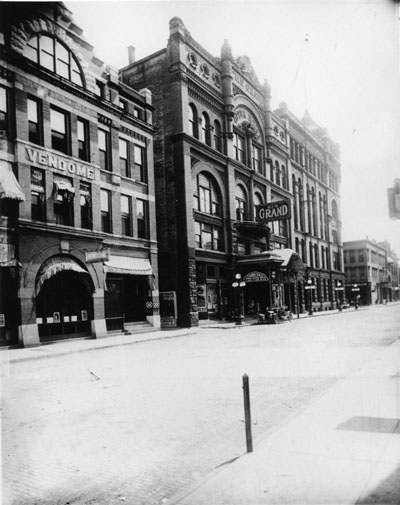 |
Grand Theater and Vendome Hotel, C. 1914. Click the picture for a larger view and to see what's showing. |
| Photo Courtesy Willard Library, Deeds 45 |
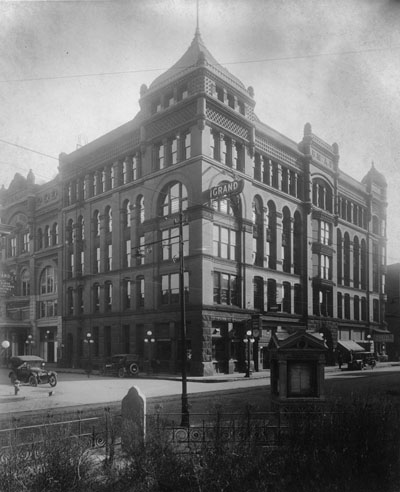 |
| Photo Courtesy Willard Library, Knecht 222 |
Grand Theater from the Old Post Office Lawn, corner of 2nd Street and Sycamore Street. The actual theater is barely visible to the left about one third of the way up from the bottom of the picture. |
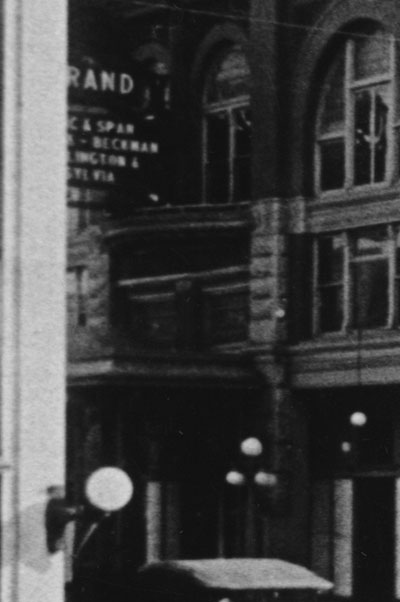 |
| Photo Courtesy Willard Library, Knecht 222 |
| Detail of the picture above showing the Grand marquee. |
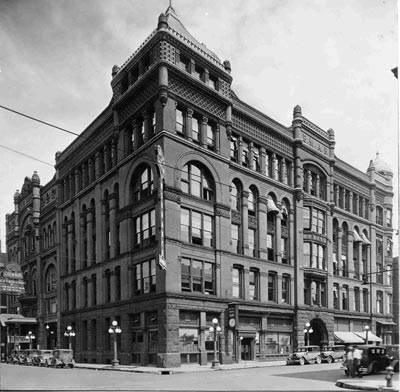 |
| Photo courtesy of the Evansville Musuem |
Grand Theater in 1930. Again the actual theater is on the extreme left about one third of the way up from the bottom of the picture. See the detail of this picture below. |
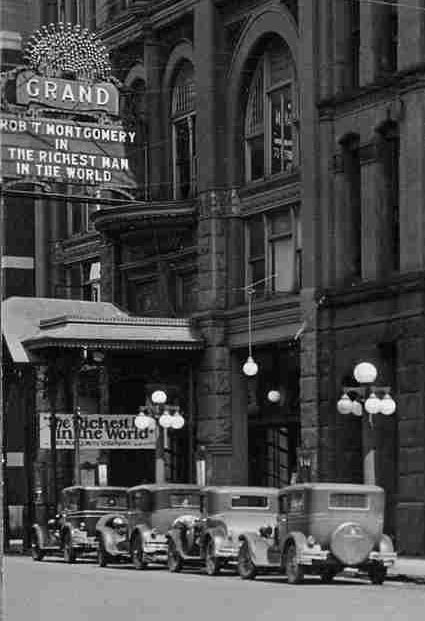 |
| Photo courtesy of the Evansville Musuem |
| The Richest Man in the World aka Sins of the Children dates this picture at 1930. |
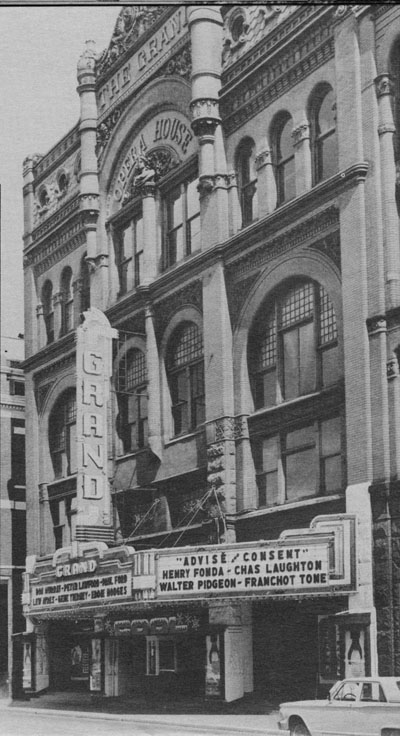 |
| Advise and Consent dates this film at 1962, the last year for the Grand Theater |